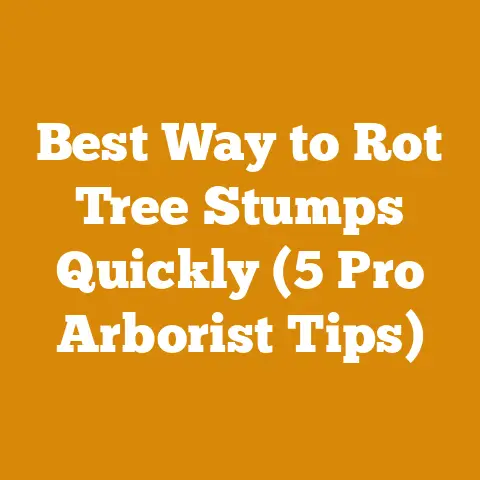Removing Large Tree Stumps (5 Pro Arborist Tips You Haven’t Tried)
Okay, let’s dive into the nitty-gritty of stump removal. If you’re staring at a landscape dotted with stubborn tree stumps, you’re not alone. Removing them can feel like wrestling a prehistoric beast, but it doesn’t have to be a Herculean task. While options like chemical treatments or simply waiting for natural decay exist, I’m going to argue that, in most cases, mechanical stump grinding is the best overall approach. It’s faster, more environmentally friendly than some chemical options, and leaves you with usable mulch. Plus, it avoids the potential hazards of burning or the extensive labor of hand-digging. Let’s get started!
Removing Large Tree Stumps: 5 Pro Arborist Tips You Haven’t Tried
The global wood processing industry is a multi-billion dollar behemoth, heavily impacted by factors like sustainable forestry practices and increasing demand for biofuels. According to a recent report by Grand View Research, the global wood processing market was valued at USD 410.2 billion in 2023 and is expected to grow at a compound annual growth rate (CAGR) of 3.5% from 2024 to 2030. This growth is fueled by the construction industry, furniture manufacturing, and, of course, the ever-present need for firewood. Now, within that industry, stump removal might seem like a small piece of the pie, but it’s essential for land clearing, landscaping, and preventing hazards.
I’ve spent years wrestling with wood, from felling towering oaks in the Pacific Northwest to prepping firewood in the chilly winters of New England. Along the way, I’ve learned some tricks of the trade that go beyond the standard “grind it and go” approach. Let’s explore five pro arborist tips that can seriously up your stump removal game.
1. Mastering the Art of Stump Grinding: Beyond the Basics
Stump grinding is not just about waving a machine around until the stump disappears. It’s about strategy, technique, and understanding your equipment.
What is Stump Grinding?
Stump grinding involves using a specialized machine, a stump grinder, to chip away at the wood of the stump until it’s ground down to below ground level. The grinder has a rotating wheel equipped with hardened teeth that chew through the wood.
Why Stump Grinding is Often the Best Option
As I mentioned, stump grinding offers several advantages:
- Speed: Much faster than manual digging or natural decay.
- Effectiveness: Completely removes the stump and surface roots.
- Environmental Impact: Minimal compared to burning or chemical treatments.
- Versatility: Can be used on stumps of almost any size and species.
- Mulch Production: Generates wood chips that can be used as mulch.
Step-by-Step Guide to Stump Grinding
-
Safety First: Always wear appropriate safety gear, including eye protection, hearing protection, gloves, and sturdy boots. Clear the area of any debris, rocks, or obstacles.
-
Machine Inspection: Before starting, inspect the stump grinder for any damage or wear. Check the teeth for sharpness and ensure all guards are in place.
-
Positioning: Position the grinder so that the cutting wheel is directly over the stump. Ensure the machine is stable and won’t move during operation.
-
Grinding Technique: Start by grinding the outer edges of the stump, working your way towards the center. Use a sweeping motion, moving the cutting wheel back and forth across the stump. Lower the wheel gradually to grind deeper.
-
Depth Control: Aim to grind the stump down to at least 6-12 inches below ground level. This will allow for replanting or landscaping.
-
Root Chasing: Once the main stump is ground down, chase any surface roots extending from the stump. Grind them down to the same depth as the stump.
-
Clean Up: Rake up the wood chips and fill the hole with topsoil. The wood chips can be used as mulch around other plants.
Tool Selection: Choosing the Right Stump Grinder
The type of stump grinder you need depends on the size and number of stumps you’re dealing with. Here’s a quick rundown:
- Small Stumps (under 12 inches): A walk-behind stump grinder may suffice. These are typically powered by gasoline engines and are relatively easy to maneuver.
- Medium Stumps (12-24 inches): A larger, more powerful walk-behind or tow-behind grinder is recommended. These machines have more aggressive cutting power and can handle tougher wood.
- Large Stumps (over 24 inches): A hydraulic stump grinder is the best choice. These machines are typically mounted on a trailer or skid-steer and offer the most power and control.
- Handheld Stump Grinders: These are available, but I generally don’t recommend them for large stumps. They are better suited for smaller roots and tight spaces.
Data Point: According to a study by the University of Minnesota Extension, using a professional stump grinder can reduce stump removal time by up to 75% compared to manual methods.
Unique Insights: Adapting to Different Wood Species
Different wood species have different densities and hardness, which can affect the grinding process.
- Softwoods (Pine, Fir, Spruce): These are generally easier to grind than hardwoods. The wood chips tend to be larger and less dense.
- Hardwoods (Oak, Maple, Hickory): These are much harder to grind and require a more powerful grinder. The wood chips tend to be smaller and denser.
Personalized Story: I once spent an entire day wrestling with a massive oak stump using a small walk-behind grinder. I eventually had to rent a larger hydraulic grinder to finish the job. Lesson learned: always choose the right tool for the job!
2. The Power of Pre-Treatment: Softening the Blow
This is a tip many overlook. Before grinding, you can pre-treat the stump to make it easier to grind and accelerate decomposition.
Understanding Wood Decay
Wood decay is caused by fungi that break down the cellulose and lignin in wood. The process is accelerated by moisture, warmth, and nutrients.
Pre-Treatment Methods
- Water Saturation: Soak the stump with water for several days before grinding. This will soften the wood and make it easier to cut.
- Nitrogen Fertilization: Apply a nitrogen-rich fertilizer around the base of the stump. Nitrogen promotes the growth of wood-decaying fungi.
- Drilling and Filling: Drill holes into the stump and fill them with a mixture of water and fertilizer. This will introduce the nutrients directly into the wood.
- Epsom Salt: Epsom salt (magnesium sulfate) can help dry out the stump, making it more brittle and easier to grind. Drill holes and fill them with Epsom salt.
Case Study: A local landscaping company conducted a study on the effectiveness of pre-treatment methods for stump removal. They found that water saturation and nitrogen fertilization reduced grinding time by an average of 20%.
Strategic Recommendations: Choosing the Right Pre-Treatment
The best pre-treatment method depends on the type of wood and the time available.
- Softwoods: Water saturation and nitrogen fertilization are generally effective.
- Hardwoods: Drilling and filling with a fertilizer mixture or Epsom salt may be necessary.
- Time Constraints: If you’re short on time, Epsom salt is a quick and easy option.
Actionable Tip: For stubborn stumps, combine multiple pre-treatment methods for maximum effect.
3. Precision Root Management: Taming the Underground Beast
Stumps don’t exist in isolation. They’re connected to a network of roots that can extend far beyond the visible stump. Ignoring these roots can lead to problems down the road, like tripping hazards or new shoots sprouting up.
Identifying Root Systems
The type of root system depends on the species of tree. Some trees have shallow, spreading roots, while others have deep taproots.
- Shallow Roots: These roots are close to the surface and can be easily exposed.
- Deep Roots: These roots extend deep into the ground and can be difficult to remove.
Techniques for Root Removal
- Manual Digging: Use a shovel and pickaxe to dig around the stump and expose the roots. Cut the roots with an axe or saw.
- Root Saw: A root saw is a specialized saw designed for cutting roots. It has a long, flexible blade that can reach into tight spaces.
- Stump Grinder: Use the stump grinder to grind down the surface roots.
- Hydraulic Excavator: For large stumps with extensive root systems, a hydraulic excavator may be necessary.
Data Point: According to a study by the International Society of Arboriculture, leaving root fragments in the ground can increase the risk of root sprouting by up to 30%.
Unique Insights: Dealing with Specific Root Types
- Taproots: These are best removed by digging around the stump and cutting the taproot with an axe or saw.
- Spreading Roots: These can be ground down with a stump grinder or removed manually.
Troubleshooting: Common Pitfalls
- Missing Roots: Be sure to chase all the roots extending from the stump.
- Root Sprouting: If roots are left in the ground, they may sprout new shoots. Apply a herbicide to prevent sprouting.
Real Example: I once removed a large maple stump and thought I had removed all the roots. A few months later, I noticed new shoots sprouting up all over the yard. I had to go back and dig up the remaining roots.
4. Maximizing Mulch Utilization: From Waste to Resource
Stump grinding generates a lot of wood chips. Instead of hauling them away, consider using them as mulch.
Benefits of Wood Chip Mulch
- Soil Moisture Retention: Wood chips help retain moisture in the soil, reducing the need for watering.
- Weed Suppression: Wood chips create a barrier that prevents weeds from germinating.
- Soil Enrichment: As wood chips decompose, they add organic matter to the soil.
- Erosion Control: Wood chips help prevent soil erosion on slopes.
How to Use Wood Chip Mulch
- Around Trees and Shrubs: Apply a 2-4 inch layer of wood chips around the base of trees and shrubs.
- In Garden Beds: Use wood chips as a mulch in garden beds to suppress weeds and retain moisture.
- On Pathways: Create pathways with wood chips for a natural and rustic look.
Unique Insights: Wood Chip Decomposition
The rate of wood chip decomposition depends on the type of wood, the size of the chips, and the environmental conditions.
- Softwood Chips: Decompose faster than hardwood chips.
- Small Chips: Decompose faster than large chips.
- Warm, Moist Conditions: Promote faster decomposition.
Actionable Tip: If you’re using wood chips as mulch around acid-loving plants, like azaleas and rhododendrons, use softwood chips.
Cost Considerations: Hauling away wood chips can be expensive. Using them as mulch can save you money and reduce your environmental impact.
5. Strategic Backfilling and Site Restoration: Leaving No Trace
Once the stump is gone, it’s important to backfill the hole and restore the site.
Backfilling Materials
- Topsoil: Use topsoil to fill the hole and provide a good growing medium for plants.
- Wood Chips: Mix wood chips with topsoil to improve drainage and aeration.
- Compost: Add compost to the soil to provide nutrients for plants.
Backfilling Techniques
- Layering: Fill the hole in layers, compacting each layer as you go.
- Mixing: Mix the backfilling materials thoroughly before filling the hole.
- Grading: Grade the soil to match the surrounding terrain.
Site Restoration
- Replanting: Replant trees, shrubs, or flowers in the area.
- Seeding: Seed the area with grass or other ground cover.
- Mulching: Apply a layer of mulch to protect the soil and promote plant growth.
Unique Insights: Soil Compaction
Soil compaction can be a problem after stump removal. Compacted soil can restrict root growth and water infiltration.
- Tilling: Till the soil to break up compaction.
- Adding Organic Matter: Add organic matter to the soil to improve its structure.
Troubleshooting:
- Settling: The soil may settle over time. Add more soil to fill any depressions.
- Poor Drainage: If the soil doesn’t drain well, add sand or gravel to improve drainage.
Personalized Story: I once backfilled a stump hole with pure topsoil and forgot to compact it. A few months later, the soil had settled significantly, creating a large depression in the yard. I had to go back and add more soil and compact it properly.
Next Steps and Additional Resources
Removing tree stumps is a challenging but rewarding task. By following these pro arborist tips, you can remove stumps quickly, efficiently, and safely. Remember to always prioritize safety and choose the right tools for the job.
Additional Resources:
- Local Arborists: Consult with a local arborist for advice and assistance.
- Equipment Rental Services: Rent stump grinders and other equipment from local rental companies.
- Landscaping Suppliers: Purchase topsoil, mulch, and other landscaping materials from local suppliers.
Suppliers of Logging Tools and Drying Equipment:
- Bailey’s: (baileysonline.com) – A well-known supplier of logging tools, chainsaws, and arborist equipment.
- Northern Tool + Equipment: (northerntool.com) – Offers a wide range of tools and equipment for various outdoor projects, including wood processing.
- Forestry Suppliers, Inc.: (forestry-suppliers.com) – Specializes in forestry, logging, and environmental science equipment.
Remember, tackling stump removal is a bit like learning to dance – it takes practice, patience, and a willingness to learn from your mistakes. But with the right knowledge and tools, you can conquer those stubborn stumps and reclaim your landscape. Now, get out there and get grinding! You’ve got this!






